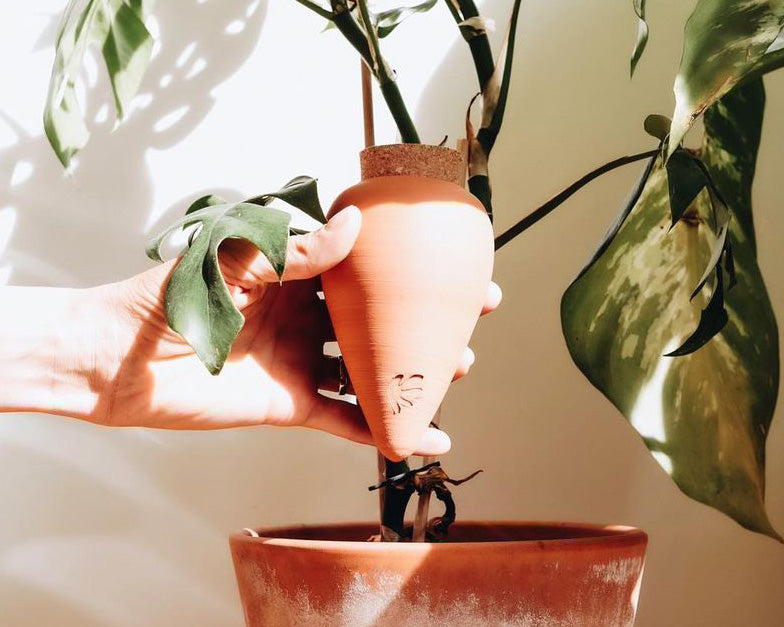This is the big trend of recent years combining plant decoration and ecological watering. Oyas, these pretty little ceramic jars to plant or bury, invest balconies, vegetable gardens and other pots of indoor plants. Used for millennia, and very popular with permaculturists, they have been the subject of work and studies to become extremely effective!
What is an oyas?
Oyas are microporous ceramic pots used to optimize plant watering. There are oyas to plant in indoor plants, and oyas to bury in vegetable gardens and balcony or terrace planters. Their principle is quite simple, and is based on the foundations of the first art of fire: ceramics.
When making a piece of ceramic, it is first shaped by hand before being fired, enamelled, and annealed. Depending on the firing temperature, the final piece will be more or less porous (see completely impermeable for stoneware for example). For the Oyas, the clay is fired at a very precise temperature, to obtain an optimal porosity and adapted to the needs of the plants.
The water is thus diffused gradually to avoid over-watering the plants and water loss by evaporation or drainage. Studies have thus shown that they make it possible to achieve water savings of around 40 to 70% (we will see below why this figure may vary).
Over time, not only will the oyas distribute water to the plant, but the plant itself will develop roots in contact with it to absorb the water it needs, the two then functioning. in symbiosis. Oyas can be made of black clay, white clay, or terracotta and belong to the class of earthenware, due to their firing temperature.
The origin of the oyas
Jar irrigation is an ancestral technique that has been used for thousands of years. It is notably mentioned in writings found in China dating back more than 2000 years. It is not known exactly where it originated, but it is certain that it has been used all over the planet's surface for hundreds of years. The term oyas comes from a “francization” of olla, which means pot, pot in Spanish.
Oyas have long been used in the context of market gardening in an empirical way, and associated with other techniques. In India, for example, it is sometimes combined with buried soaked cotton threads, to compensate for poorly controlled porosity. But in the 1960s, with the advent of permaculture, and under the impetus of Bill Mollison who mentioned them in his documentary “the global gardener”, oyas became an object of study.
Research has been carried out to refine the technique to make it more optimal. This is how oyas for planting appeared in the course of the 2000s, in order to allow their use for urban purposes, by giving them a decorative dimension as well.
What are the interests of the oyas?
The interests of the oyas are numerous. They are economical, ecological, water your plants intelligently, limit the appearance of unwanted weeds, adapt to climatic conditions, and can be used with almost all plants. But let's go into more detail for 3 of them:
Simplify the watering of houseplants
This is arguably the most important benefit for many of us. The oyas to plant allow you to no longer worry about when, how, and how much water to use to water your plants. It is sometimes cumbersome to have to manage the watering of your plants. And this is today the main reason why some people are reluctant to invest in plants.
Rightly so, when you know that it is above all over-watering that kills plants through root rot. The most classic mistake is to say to yourself: "Hey, it's been a long time since I watered my plant, its leaves are fading, I'll quickly pour a pitcher of water on it to be quiet". The results can often be catastrophic. The plant finds itself drowned and, deprived of oxygen, the roots end up rotting.
Thanks to the oyas, the plants will be able to draw the water they need themselves. No more watering headaches, the oyas is empty, all you have to do is fill it up, and you're done. Most oyas last 4-7 days, but the time between waterings can be a little longer, especially for houseplants, which often need short dry spells to stimulate flowering. So whether you have a green thumb or not, the oyas will do the work for you, and your plants will grow on their own.
Save water
Let's start from the fundamentals and be precise. When you water a plant, the available water will disappear in three ways. If the watering is greater than the soil's holding capacity, it will be drained. Either it will come out of the pot from the bottom, or it will reach the water tables in natural soil.
The remaining water will be eliminated by the phenomenon of evapotranspiration. That is to say that a part will be evaporated by the surface of the ground, in contact with the heat produced by the sun, and the wind. And the other part will be transpired by plants. This transpiration is a fundamental element of the life of the plant, it allows the sap to rise from the roots in order to supply the photosynthesis with minerals and to refresh it. Sweating is essential.
The oyas are therefore very interesting insofar as they increase the water reserves of the soil. They avoid losses by evaporation linked to surface watering while allowing the plant to maintain its transpiration continuously, limiting water stress for plants as much as possible.
Measuring the water savings achieved thanks to oyas is however complex because it will depend on the heat, the type of soil, and the rain (for outdoor plants). However it is fair to say that these savings can vary from 40 to 70% depending on these parameters. Which in the end will help to make the investment made when buying your oya profitable.
Maintain soil fertility and life
The issue of living soils has become major in recent years. The considerable work carried out by collectives such as “Vers de terre production”, highlights the importance of the link between living soil and soil fertility. To put it simply, having a soil rich in micro and macro organisms makes it possible to transform organic matter into elements assimilable by plants, and therefore to promote their growth.
However, to maintain a living soil, it is necessary to provide lodging and cover for all this biodiversity. And this is where oyas get particularly interesting! A habitat suitable for life must necessarily remain humid. A dry soil on the first 20 cm of the ground will block the activity of all this unknown and often invisible fauna, and prevent its development.
By combining oyas and mulching, you will boost the fertility of your soils and you will contribute to bringing to life the first links in the chains of biodiversity which really need it right now! And it will be beneficial for your plants which will flourish in a rich and fertile ecosystem. If you are starting a small vegetable patch on poor quality soil, it may also be useful to combine the installation of oyas with the addition of organic fertilizer to stimulate soil activity in the spring.
The question of living soils for indoor plants is also considered too little, even though it is possible to transpose certain principles, and in particular certain forms of mulching suitable for interiors. If the theme interests you, you will find all the information in our complete guide to organic fertilizers for indoor and vegetable plants.


